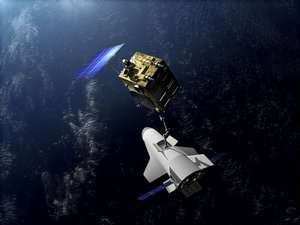Programme for Reusable In-orbit Demonstrator in Europe
|
Artist's view of the PRIDE spaceplane servicing a satellite | |
| Names | PRIDE |
|---|---|
| Mission type | Reusable spaceship |
| Operator | ESA |
| Orbital parameters | |
| Reference system | Geocentric |
The Programme for Reusable In-orbit Demonstrator in Europe (PRIDE) is a European Space Agency (ESA) programme that aims to develop a reusable robotic spacecraft. PRIDE was approved at the ESA Ministerial Council in Naples, Italy on November 21, 2012. PRIDE spaceplane will be similar to, but smaller and cheaper than, the Boeing X-37. It will be launched by the Vega light rocket, operate robotically in orbit, and land automatically on a runway.[2]
History
PRIDE was initially funded by the European Space Agency (ESA) on November 21, 2012, at the ESA Ministerial Council in Naples, Italy.[3] The project was created with the objective of creating a small unmanned spaceplane that was also affordable and reusable. During the initial design stage the vehicle was referred to as PRIDE-ISV. The suffix ISV stands for Innovative Space Vehicle.[4] The PRIDE development team is projected to begin industrial activities in September 2015. In December 2015 a ministerial-level meeting will make a decision regarding the funding for the project as around €200 million is required to finalize the project, excluding launch costs. If funding is successful, the first launch is expected around 2020.[5]
The European Space Agency has developed two test vehicles: the Atmospheric Reentry Demonstrator (launched in 1998), and the Intermediate eXperimental Vehicle (IXV, launched on 11 February 2015 [6] and with a second launch planned for 2019 or 2020).[1][4][7]
Design
With affordability in mind, the PRIDE spaceplane will be based on technologies developed and tested on the IXV. Final specifications of the spaceplane have not yet been determined; both winged and lifting body variants are under consideration.
The PRIDE spaceplane will be capable of launching a 300 kg payload into orbit. It will be equipped with solar panels, allowing for extended in-orbit operations. Vega will be used as a launch vehicle.[1][8]
The PRIDE spaceplane will be used as an orbital test platform for re-usable launcher stages, Earth observation, robotic exploration, servicing of orbital infrastructures, and microgravity experiments.[8]
See also
- Boeing X-37 - A comparable United States Air Force spaceplane
- Atmospheric Reentry Demonstrator (ARD) - ESA reentry testbed flown in 1998
- Avatar space shuttle (India)
- European eXPErimental Re-entry Testbed (EXPERT) - Research programme developing materials used in IXV
- Future Launchers Preparatory Programme - parent programme for IXV
- Hopper - an earlier ESA project on developing manned spaceplane, cancelled
References
- 1 2 3 Howell, Elizabeth (23 February 2015). "Europe's Newly-Tested Space Plane Aims for Next Launch in 2019". Space.com. Retrieved 16 June 2015.
- ↑ "Frequently Asked Questions on IXV". ESA. 9 February 2015. Retrieved 4 July 2015.
- ↑ "N° 37–2012: European Ministers decided to invest in space to boost Europe's competitiveness and growth" (Press release). ESA. 21 November 2012. Retrieved 16 June 2015.
- 1 2 Rob Coppinger (25 October 2012). "IXV's Pride: Europe's spaceplane homecoming prelude to future goals". Space.com. Retrieved 16 June 2015.
- ↑ Wall, Mike (16 June 2015). "Replay of IXV conference". ESA. Retrieved 17 July 2015.
- ↑ "European Mini-Space Shuttle Aces 1st Test Flight". Space.com. 11 February 2015. Retrieved 16 December 2015.
- ↑ "Europe's mini-space shuttle returns". BBC News. 11 February 2015. Retrieved 16 June 2015.
- 1 2 "ESA spaceplane on display" (Press release). ESA. 16 June 2015. Retrieved 17 June 2015.
External links
- PRIDE mission image
